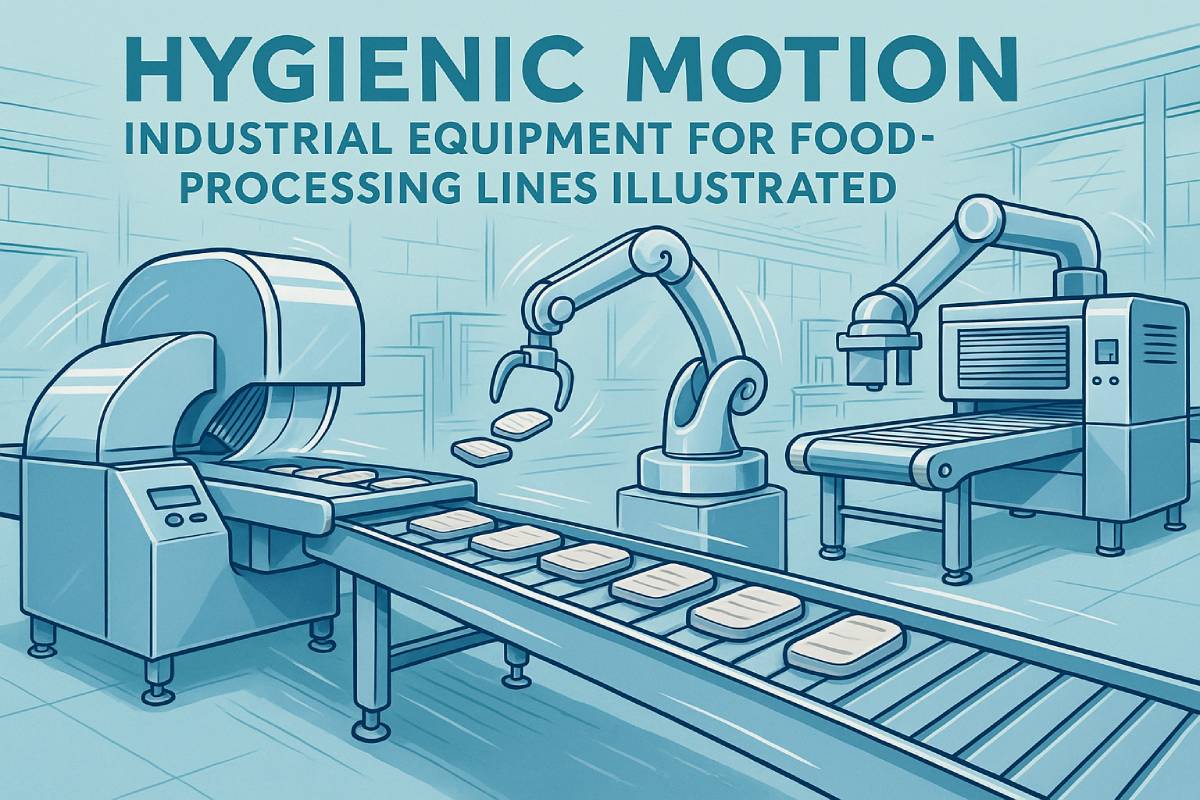Food plants marry two worlds that rarely overlap elsewhere in manufacturing: strict sanitary regulation and relentless high‑speed automation. Every gearbox, chain, and servo axis must accelerate thousands of portions per hour, then survive daily assaults of 70 °C caustic foam, high‑pressure rinse, and near‑freezing production shifts.
Bosch Rexroth’s MDD112D‑N‑030‑N2M‑130PB3 synchronous motor makes a useful lens through which to examine how equipment is specified, integrated, and maintained for this environment.
What the Motor Brings to the Table
The MDD112D frame is a 112 mm‑flange permanent‑magnet servo that delivers 38 N·m continuous standstill torque and a nominal 3,000 rpm speed from a compact “D” length housing.
A digital multiturn absolute encoder lives under the rear cap, and the factory builds the shaft with a seal and keyway so it can face an atmosphere laced with brine or sugar dust without leaking grease into product zones.
The 130 mm centering diameter and side‑B connector pattern allow quick swaps during sanitation windows, while the seal‑protected bearings stay lifetime‑lubricated—critical because food‑grade greases cost several times more than standard grades and must never migrate onto stainless work surfaces.
Conveyor Drives: The Backbone of Bulk Flow
Bulk conveyors moving debagged vegetables or trimmed meat typically need 15–40 N·m at roller shafts once gear reduction is counted. One MDD112D can serve a belt up to 20 m long while coasting at 60 % of its continuous torque rating—headroom is necessary when the belt sees a transient load as totes dumping.
Mounting rules differ from general industry: the motor usually sits just outside the primary (hygienic) zone on a stainless C‑frame, with its power/feedback connector routed through a hygienic gland. That arrangement lets the wash‑down lance scour the belt area without spraying directly at the servomotor; an IP65 body is adequate here, whereas IP69K stainless designs are often reserved for in‑zone actuators, doubling or triple the bill of materials.
Portion Control: Indexing Slicers and Depositors
Servo axes that meter dough ribbons, deli meat, or cheese blocks demand fast position loops. The MDD112D’s rotor inertia—about 0.012 kg · m²—is low for a motor in this torque class, keeping settle times under 60 ms when paired with an IndraDrive C controller.
By combining the encoder’s multiturn data with the drive’s Safe Torque Off (STO) channel, machine builders meet EN 14120 functional safety targets without the extra complexity of external resolvers. Sensors inside the gearbox compare live temperature against the drive’s thermal model; if caustic fluid overheats the stage during sanitizing, the controller inhibits enable until the windings cool below 80 °C, preventing condensation inside the stator after a hot‑wash, cold‑production cycle.
Pick‑and‑Place Robotics: Secondary‑Packaging Automation
Top‑load carton formers or delta robots often sit immediately downstream of the slicing line. They must meet the same sanitary design checklist—sloped surfaces for draining, no exposed threads above product, minimal crevices—and yet accelerate payloads several metres per second squared.
Because the MDD112D reaches 231 N·m peak (six times continuous) for up to a second, a single axis can lift a six‑lane infeed of pouches and drop them into cartons without stalling. The motor’s sealed shaft mitigates microbial ingress when the gripper tool drips marinade or puree.
For true in‑zone robot joints, designers usually slip a one‑piece stainless shroud over the Rexroth body or relocate the motor outside the cage and drive the arm through a composite wash‑down‑rated belt.
Hygienic Design Beyond the Motor
Regulatory bodies such as EHEDG and 3‑A teach that motors are only as cleanable as their surroundings. Competing stainless‑steel servos—Kollmorgen AKMH, Rockwell VPH, Baumüller HYG1—all advertise IP69K housings with zero flat surfaces, proving how far vendors go to remove harbourage sites. When a plant chooses a standard IP65 Rexroth unit instead, the OEM compensates by:
- placing the motor in a dry zone and using sealed stainless shafts or magnetic couplings to penetrate the product guard;
- covering the housing with FDA‑compliant sleeve boots or STEEL‑IT epoxy to withstand chlorine foam;
- specifying shaft seals and cable glands rated for CIP detergents to preserve the motor’s NEMA ingress rating throughout its life.
Cleaning‑In‑Place and Thermal Cycling
CIP routines hammer motors harder than any production cycle. Water at 70 °C expands the air inside a servo faster than the vent membrane can breathe, forcing condensate past gasket lips. Once production restarts at 2 °C ambient, that moisture condenses inside the encoder cavity, leading to phantom feedback faults.
Best practice is to air‑purge the cabinet with dry compressed filtration during hot phases and add a short vacuum pull‑down before line start. The MDD112D’s encoder electronics tolerate 100 % relative humidity but only if the connector’s O‑ring stays supple; maintenance crews record its Shore A hardness each quarterly PM and replace seals that age‑harden.
Lubrication and Food Safety
Traditional open‑frame conveyors drip gearbox oil onto shafts inches from raw food. A servo/planetary reducer package driven by the MDD112D uses food‑grade ISO 220 synthetic grease sealed for life, eliminating that risk.
Because the motor itself has no oil reservoir, the only contamination path would be overheating, which purges bearing grease. IndraDrive firmware monitors winding temperature and derates torque automatically, cutting axis power before the 155 °C insulation limit is approached.
Maintenance and Detectable Failures
A preventive plan in food service differs from that in automotive press lines: downtimes are shoehorned between sanitation and allergen‑changeovers rather than weekends. For the MDD112D, critical tasks are visual seal inspection, vibration trending, and encoder checksum logging.
The motor’s digital feedback stores runtime hours; a historian flag prompts service when the total exceeds 35,000—roughly seven years on two‑shift duty—because bearing grease then nears oxidation thresholds even without visible wear.
The worst practice is bypassing early‑fault warnings to “push the batch through.” Every STO trip or over‑temperature event that operators reset blindly inches the winding thermoset closer to delamination. Proper culture downloads the fault stack after each shift and archives it beside CIP cycle counts so engineering can correlate moisture ingress with failure modes rather than blame the asset.
Integration with Stainless Actuators and Valves
Servo motors rarely act alone. Hygienic actuators like Tolomatic ERD or SMC HF2A rods feature IP69K scrapers and drain ports so they can live above the product. When those rods mount to a slide driven by an MDD112D, the slide shield must overlap the motor flange enough to redirect chemical splash yet leave a hand‑width gap for inspection.
Food‑grade UHMW‑PE couplings isolate shaft electricity—the main culprit behind pitting in brine atmospheres—while still meeting FDA CFR 21 standards.
Choosing Between IP65 and IP69K
Why would a plant ever favour an IP65 Rexroth servo over a stainless IP69K unit? Cost and network uniformity dominate.
A full stainless motor can cost three to four times more; an MDD112D already in the plant’s spares crib plugs directly into the same IndraDrive firmware and Sercos profiles that run palletizers six rooms away. The trade is extra design discipline in guarding, purging, and cleaning procedures rather than hardware premium.
When Repairs Trump Replacement
If a seal fails or a bearing pits from caustic intrusion, scrapping isn’t the only option. Wake Industrial stocks refurbished MDD112D‑N‑030‑N2M‑130PB3 units and offers encoder swaps, stator re‑impregnation, and FDA‑grade seal retrofits in as little as three business days, including dynamometer testing under humid‑heat soak.
For plants moving toward full hygienic designs, Wake can overcoat repaired housings with NSF H1‑approved epoxy to extend usable life until capital budgets allow all‑stainless replacements. Wake Industrial is a trusted independent repair and replacement source—never an authorized Bosch Rexroth distributor—and can preload your exact parameter file so installation after sanitation takes minutes, not hours.
Final Thoughts
Food‑processing machinery hides a paradox: it must be scrubbed so aggressively each night that few industrial components can survive, yet it must remain precise enough to portion grams of cheese or slices of deli meat at 400 units‑per‑minute.
By analysing the Bosch Rexroth MDD112D‑N‑030‑N2M‑130PB3 in context—torque curve, encoder durability, seal design—engineers can set reliable foundations for conveyors, slicers, and robotic packers without defaulting to cost‑prohibitive exotic hardware. Respect the hygiene envelope with smart placement, seal stewardship, and real‑time diagnostics, and an IP65 servo can thrive in the wettest, saltiest corners of a USDA plant.
Need help sizing a reducer, sourcing a same‑day replacement, or hardening an existing servo against tomorrow’s sanitation audits? Contact Wake Industrial today and keep your line—and your food—moving safely.





















